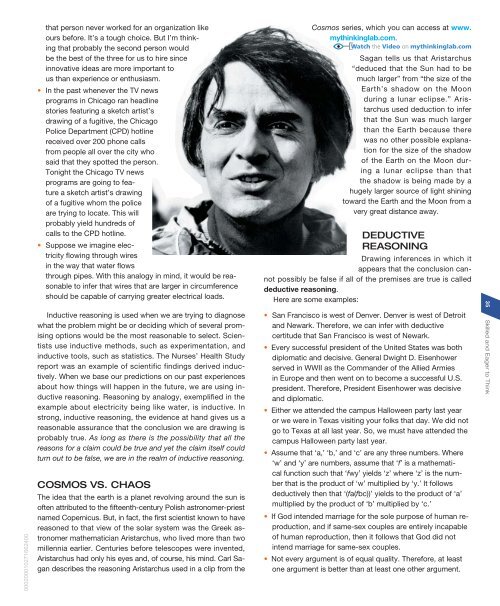Critical Thinking Disposition Self- Rating Form. - Pearson Learning ...
Critical Thinking Disposition Self- Rating Form. - Pearson Learning ...
Critical Thinking Disposition Self- Rating Form. - Pearson Learning ...
Create successful ePaper yourself
Turn your PDF publications into a flip-book with our unique Google optimized e-Paper software.
that person never worked for an organization like<br />
ours before. It’s a tough choice. But I’m thinking<br />
that probably the second person would<br />
be the best of the three for us to hire since<br />
innovative ideas are more important to<br />
us than experience or enthusiasm.<br />
• In the past whenever the TV news<br />
programs in Chicago ran headline<br />
stories featuring a sketch artist’s<br />
drawing of a fugitive, the Chicago<br />
Police Department (CPD) hotline<br />
received over 200 phone calls<br />
from people all over the city who<br />
said that they spotted the person.<br />
Tonight the Chicago TV news<br />
programs are going to feature<br />
a sketch artist’s drawing<br />
of a fugitive whom the police<br />
are trying to locate. This will<br />
probably yield hundreds of<br />
calls to the CPD hotline.<br />
• Suppose we imagine electricity<br />
flowing through wires<br />
in the way that water flows<br />
through pipes. With this analogy in mind, it would be reasonable<br />
to infer that wires that are larger in circumference<br />
should be capable of carrying greater electrical loads.<br />
Cosmos series, which you can access at www.<br />
mythinkinglab.com.<br />
Watch the Video on mythinkinglab.com<br />
Sagan tells us that Aristarchus<br />
“deduced that the Sun had to be<br />
much larger” from “the size of the<br />
Earth’s shadow on the Moon<br />
during a lunar eclipse.” Aristarchus<br />
used deduction to infer<br />
that the Sun was much larger<br />
than the Earth because there<br />
was no other possible explanation<br />
for the size of the shadow<br />
of the Earth on the Moon during<br />
a lunar eclipse than that<br />
the shadow is being made by a<br />
hugely larger source of light shining<br />
toward the Earth and the Moon from a<br />
very great distance away.<br />
DEDUCTIVE<br />
REASONING<br />
Drawing inferences in which it<br />
appears that the conclusion cannot<br />
possibly be false if all of the premises are true is called<br />
deductive reasoning.<br />
Here are some examples:<br />
35<br />
000200010271662400<br />
Inductive reasoning is used when we are trying to diagnose<br />
what the problem might be or deciding which of several promising<br />
options would be the most reasonable to select. Scientists<br />
use inductive methods, such as experimentation, and<br />
inductive tools, such as statistics. The Nurses’ Health Study<br />
report was an example of scientific findings derived inductively.<br />
When we base our predictions on our past experiences<br />
about how things will happen in the future, we are using inductive<br />
reasoning. Reasoning by analogy, exemplified in the<br />
example about electricity being like water, is inductive. In<br />
strong, inductive reasoning, the evidence at hand gives us a<br />
reasonable assurance that the conclusion we are drawing is<br />
probably true. As long as there is the possibility that all the<br />
reasons for a claim could be true and yet the claim itself could<br />
turn out to be false, we are in the realm of inductive reasoning.<br />
COSMOS VS. CHAOS<br />
The idea that the earth is a planet revolving around the sun is<br />
often attributed to the fifteenth-century Polish astronomer-priest<br />
named Copernicus. But, in fact, the first scientist known to have<br />
reasoned to that view of the solar system was the Greek astronomer<br />
mathematician Aristarchus, who lived more than two<br />
millennia earlier. Centuries before telescopes were invented,<br />
Aristarchus had only his eyes and, of course, his mind. Carl Sagan<br />
describes the reasoning Aristarchus used in a clip from the<br />
• San Francisco is west of Denver. Denver is west of Detroit<br />
and Newark. Therefore, we can infer with deductive<br />
certitude that San Francisco is west of Newark.<br />
• Every successful president of the United States was both<br />
diplomatic and decisive. General Dwight D. Eisenhower<br />
served in WWII as the Commander of the Allied Armies<br />
in Europe and then went on to become a successful U.S.<br />
president. Therefore, President Eisenhower was decisive<br />
and diplomatic.<br />
• Either we attended the campus Halloween party last year<br />
or we were in Texas visiting your folks that day. We did not<br />
go to Texas at all last year. So, we must have attended the<br />
campus Halloween party last year.<br />
• Assume that ‘a,’ ‘b,’ and ‘c’ are any three numbers. Where<br />
‘w’ and ‘y’ are numbers, assume that ‘f’ is a mathematical<br />
function such that ‘fwy’ yields ‘z’ where ‘z’ is the number<br />
that is the product of ‘w’ multiplied by ‘y.’ It follows<br />
deductively then that ‘(fa(fbc))’ yields to the product of ‘a’<br />
multiplied by the product of ‘b’ multiplied by ‘c.’<br />
• If God intended marriage for the sole purpose of human reproduction,<br />
and if same-sex couples are entirely incapable<br />
of human reproduction, then it follows that God did not<br />
intend marriage for same-sex couples.<br />
• Not every argument is of equal quality. Therefore, at least<br />
one argument is better than at least one other argument.<br />
Skilled and Eager to Think<br />
Think <strong>Critical</strong>ly, by Peter Facione and Carol Ann Gittens. Published by Prentice Hall. Copyright © 2013 by <strong>Pearson</strong> Education, Inc.

















